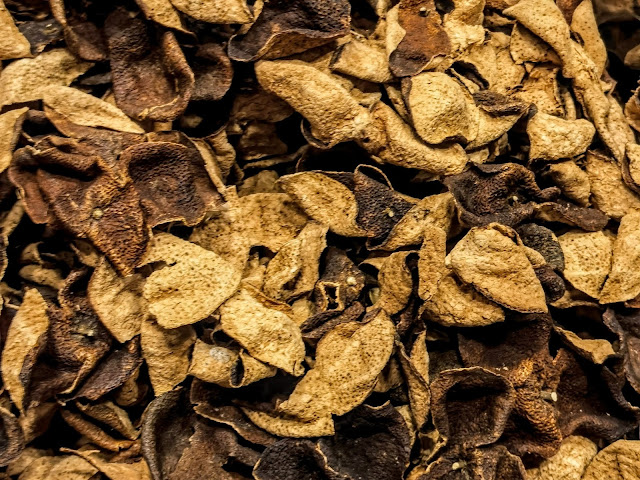Chenpi or dried tangerine peel is made from tangerine duh..... . (Image credit Wikipedia.)
Chenpi is one of the Three Treasures of Guangdong 广东三宝. The other two are aged ginger 老姜 and hay 禾杆草.
The best chenpi are made with 茶枝柑 tangerine from Xinhui 新会
district of China's Guangdong province. Xinhui district is well irrigated
as it is located at the confluence of Tanjiang River, Sanjiangkou River
and Xijiang River. The soil is especially rich with minerals. The sunny
and dry climate is also good for drying tangerine peels. (Image courtesy
of
Wikipedia.)
The process of making chenpi is a millennium old art.
When the tangerine trees fruit, some of the fruits on the tree are
harvested while they are still green. This allows the remaining fruits to
receive more nutrients. The fruits are partially harvested again as they
turn orange colour. Finally, the best fruits are allowed to ripen to a
reddish colour which received the most nutrients.
Nothing is wasted as green and orange fruits are used to make lower grade
chenpi while red fruits are for premium red chenpi.
There are three types of chenpi made with tangerines at different stages of
ripeness when they are harvested - green 青柑, orange 二红柑 and red
大红柑 being the premium.
The fruit skin is cut and removed in a one piece peel like a 3 petal
flower. The tangerine skin rich with oil sacs and moisture is about 1mm
thick at this stage.
The tangerine peel is sun dried for 5 - 6 days.
The sun dried peels are packed into air tight containers, kept in a cool,
dry place and brought out for sunning once a year. Even the lowest grade
chenpi requires at least 3 years of storage and sunning. The older the
peels, the better, so peels kept for more than 50 years are not unheard
of.

|
| Image credit: Wikipedia |
Chenpi aged 3 years still have a citrus fragrance 果香.
Chenpi aged 10 years have an aged wood fragrance 陈香.
Chenpi aged 30 years have a medicinal fragrance 药香.
Only red chenpi improves with age beyond 10 years - green and orange chenpi
don't. The skin of red chenpi is hard, very thin, becoming thinner with
age. There is a slight oily sheen as drying break the oil sacs. It is
fragrant. The longer red chenpi is kept, the more fragrant it becomes.
It takes 20 kilos of fresh tangerines to make 1 kilo of chenpi.
As red chenpi is precious, do be extra cautious about fake red chenpi in
the market. To make young chenpi look older, sellers are known to soak
tangerine peels in Chinese black tea before drying. For the uninitiated, it
is difficult to tell the different grades of chenpi apart. Some unscrupulous
sellers take advantage of buyers' ignorance.
Chenpi is very versatile and is used in many Cantonese dishes, desserts
and beverages. Records of Chenpi use in medicine and cuisine date back to the Song
dynasty (960–1279).
In traditional Chinese medicine, red chenpi is used with other herbs in concoctions to support blood circulation, respiratory system, appetite,
digestion, reproductive health, etc. It has no known side effects.
Chenpi is used in Cantonese style steamed dishes, stews, soups etc where it
imparts a layer of signature 甘甜 kum sweet flavour and 甘香 kum sweet aroma to the dish.
The same 甘甜甘香 kum sweet flavour and aroma infuse Cantonese
style red bean soup and other desserts when chenpi is used.
Family heirloom red chenpi are gifted to brides. It is used in post-natal
dishes to support the nursing mother's recovery.
Chenpi can also simply be used as a hot beverage such as chenpi tea or in a blend with Chinese black tea.
Translated by Tony Boey on 11 Feb 2021





very informative! thank you
ReplyDelete